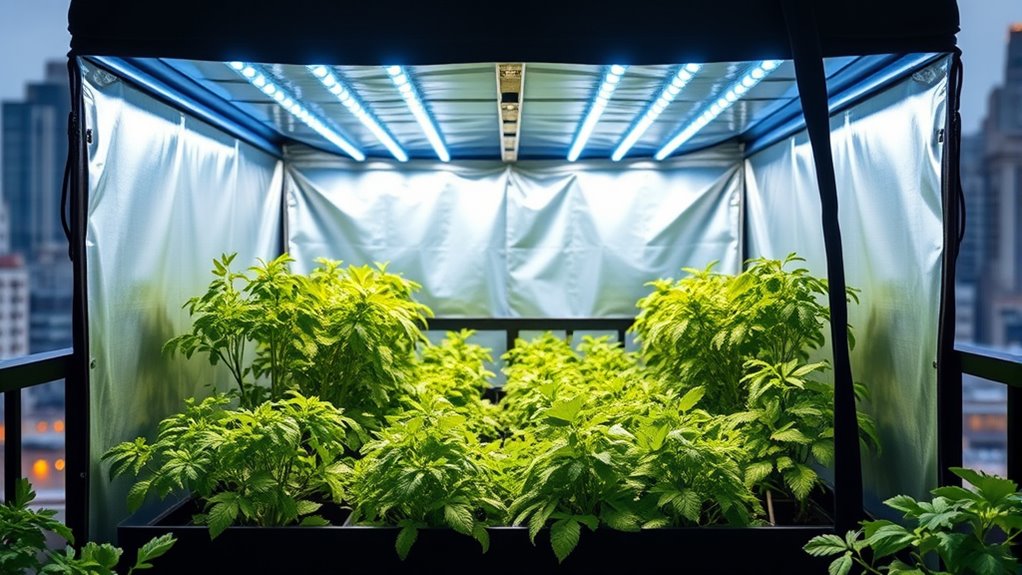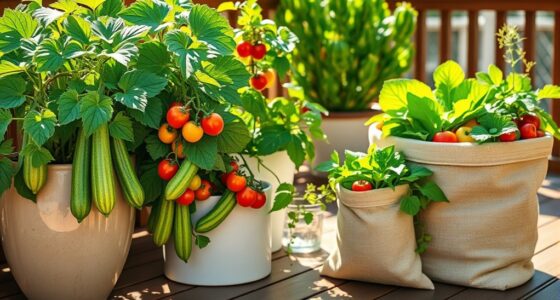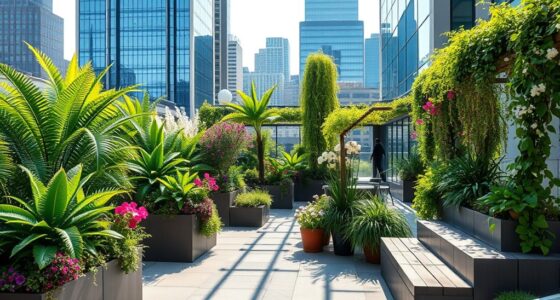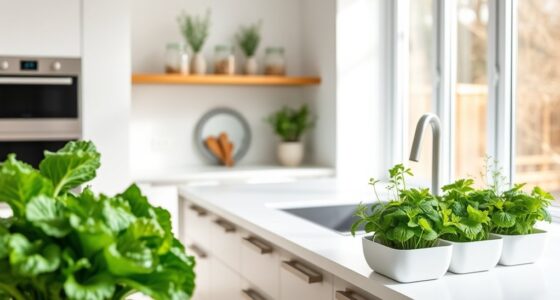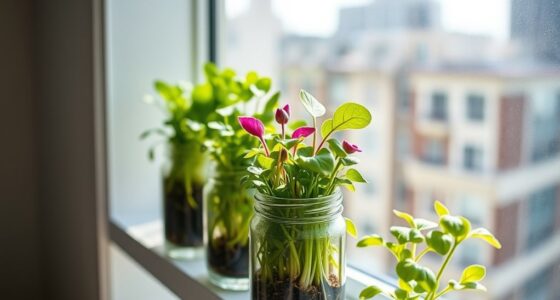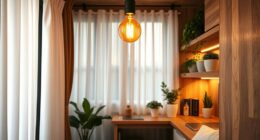Grow tents play a crucial role in urban gardening by helping you maximize limited space and control the environment. They provide a compact, portable, and enclosed area where you can manage light, temperature, humidity, and odor effectively. This guarantees healthier plants and higher yields despite the constraints of small indoor settings. If you keep exploring, you’ll discover how to optimize your grow tent setup for consistent success.
Key Takeaways
- Maximize limited urban space through vertical and compact indoor gardening within an enclosed environment.
- Enhance light efficiency and plant growth using reflective interior linings like Mylar.
- Provide stable environmental conditions—temperature, humidity, and odor control—regardless of external surroundings.
- Facilitate precise monitoring and automation for optimal plant health and yield.
- Offer portability and quick setup, making year-round urban gardening practical and discreet.
Benefits of Grow Tents for Compact Urban Spaces
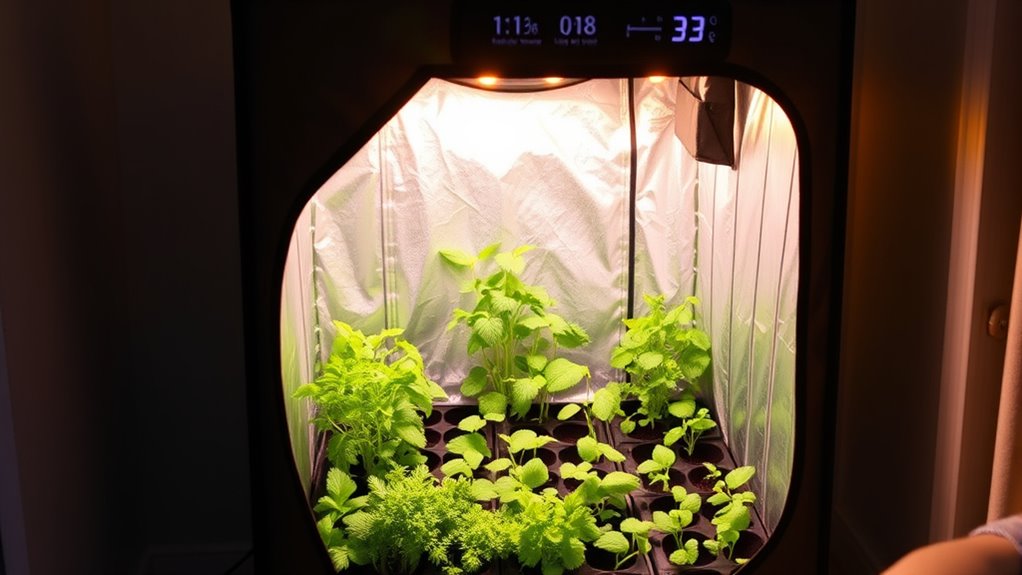
In small urban spaces, grow tents offer an efficient solution for indoor gardening. These structures maximize your limited space by creating a dedicated, enclosed environment perfect for urban gardening. Their compact design allows you to grow vertically, increasing plant capacity without taking up more floor area. The reflective interior lining boosts light efficiency, ensuring your plants get the maximum illumination they need to thrive. Grow tents are portable and easy to set up, making them ideal for flexible, year-round indoor gardening in small apartments or shared spaces. Plus, they help you maintain consistent environmental control, stabilizing temperature, humidity, and odor levels. Environmental control makes indoor gardening more manageable and productive, even within the constraints of a confined, urban environment.
Essential Components and Features of Modern Grow Tents
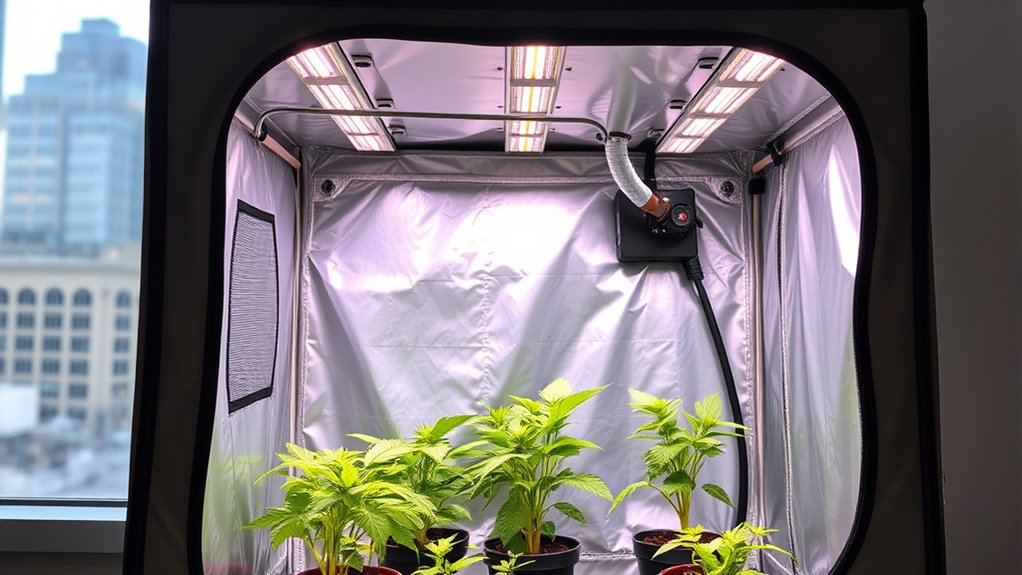
Modern grow tents feature a sturdy yet lightweight frame made of aluminum or steel, making setup quick and stable. Inside, reflective materials like Mylar maximize light efficiency by spreading it evenly across your plants. These components are essential for creating an ideal environment and ensuring healthy growth. Additionally, incorporating high-quality projectors can help monitor plant growth through detailed imaging and improve overall cultivation techniques. Advances in AI-powered monitoring tools are increasingly being integrated into grow tents to provide real-time data and optimize growing conditions for better yields. Moreover, integrating environmental control systems enhances the ability to maintain optimal temperature and humidity levels automatically. Incorporating climate regulation technology can further improve environmental stability, promoting healthier plant development.
Structural Framework Design
The structural framework of a grow tent is essential for providing stability and supporting all internal components. A well-designed grow tent features a sturdy, lightweight aluminum or steel frame that ensures durability and ease of setup. The design emphasizes stability, preventing wobbling or collapsing during use. Modular elements, such as adjustable height extensions or removable panels, allow you to customize the tent’s size to suit your plants’ needs. Reinforced seams and strategically placed vents integrate seamlessly into the framework, facilitating ideal ventilation and airflow. This support system also helps maintain environmental control, ensuring that internal conditions stay consistent. Additionally, incorporating gears and mechanical elements into the design can enhance adjustability and add a touch of Victorian-inspired industrial aesthetic.
Reflective Interior Materials
Reflective interior materials are essential components of grow tents, as they maximize light efficiency and promote even plant growth. These materials, like Mylar or high-quality reflective fabric, help achieve ideal light distribution.
The reflective lining typically boasts over 90% reflectivity, ensuring more effective use of grow lights and reducing energy costs. Mylar, with its mirror-like surface, reflects light uniformly across all plant surfaces, enhancing plant growth efficiency.
High-quality reflective fabric offers durability, moisture resistance, and easy cleaning, maintaining reflectivity over time. Utilizing light reflectivity in the design of grow tents can significantly boost plant yields by optimizing light exposure.
- Maximize light distribution for uniform growth
- Improve plant growth efficiency with high reflectivity
- Reduce energy costs through better light use
- Ensure durability and easy maintenance with reflective lining
Setting Up a Grow Tent in Limited Indoor Areas
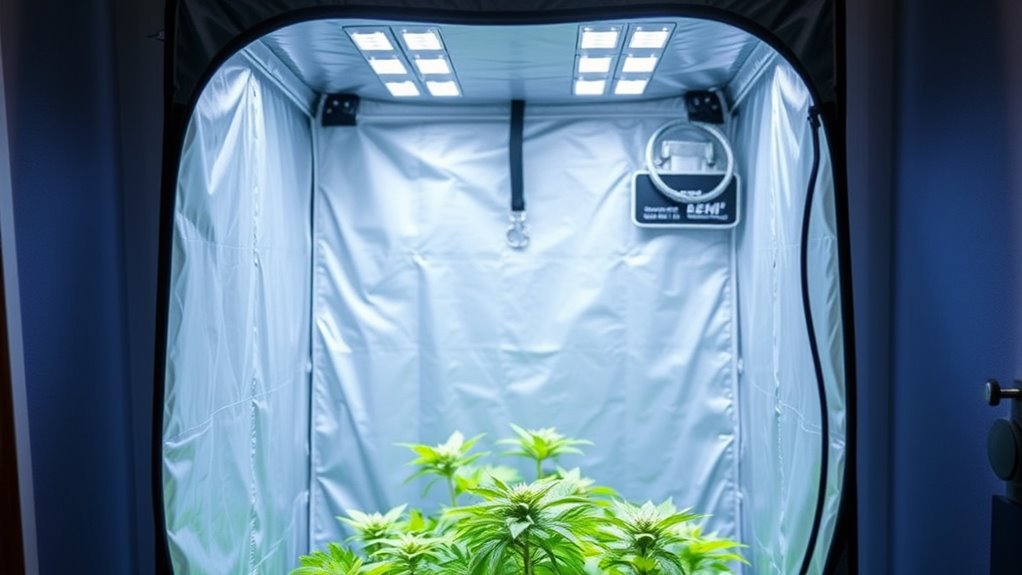
To make the most of limited indoor space, choose a compact grow tent size that fits comfortably without overcrowding your plants. Position it in a well-ventilated area near electrical outlets for easy access to lighting and climate control equipment. Use vertical space inside the tent by hanging lights and tools. Monitor environmental conditions regularly to keep everything ideal. Incorporate proper ventilation to ensure healthy airflow and prevent issues like mold or pests. Additionally, regularly updating your environmental controls helps maintain optimal growing conditions and can prevent problems before they arise. For added efficiency, consider using self watering plant pots to maintain consistent moisture levels and reduce the need for frequent watering. Checking the retail hours of nearby stores can also help you plan your shopping for supplies more effectively. Ensuring your plants are exposed to appropriate light is essential for healthy growth and maximizing yields.
Space-efficient Design Tips
Maximizing limited indoor space requires thoughtful planning when setting up a grow tent. To make the most of your space, choose a compact size, like 2.3 x 2.3 meters, to fit snugly into corners or unused rooms. Incorporate rustic decor elements such as vintage signage or antique accents to create a cozy atmosphere. Position the tent strategically to avoid obstructing walkways and maximize airflow. Inside, utilize vertical space by installing hanging racks, shelves, or adjustable grow lights, boosting your grow tents’ efficiency. Ensure your grow tent has proper ventilation ports and is near power sources, reducing clutter and extension cords. For added convenience, opt for lightweight, portable grow tents with quick setup and dismantling features, allowing easy repositioning within tight spaces. Additionally, considering vibrational energy can help maintain a harmonious environment for your plants, aligning with natural growth rhythms. Incorporating space optimization techniques can further enhance your setup and ensure your plants thrive in the limited area. Being mindful of light distribution is also crucial to promote even growth and maximize photosynthesis. This approach not only enhances plant health but also supports a more productivity-focused gardening environment. These tips help optimize your urban gardening setup without sacrificing functionality.
Equipment Placement Strategies
Placing your grow tent in the right spot is essential for efficient operation, especially in limited indoor spaces. Proper ventilation and equipment placement are key to maintaining ideal airflow and environmental conditions.
Position the tent near electrical outlets and ventilation options to ensure easy access to power and adequate airflow. Arrange fans, lights, and carbon filters around vents and ports, avoiding obstructions that could hinder airflow or complicate maintenance.
Use adjustable shelving or hanging straps inside the tent to maximize space utilization and keep equipment at appropriate heights. Place environmental monitoring tools, like thermometers and hygrometers, at plant level for accurate readings.
Select a location that minimizes drafts, direct sunlight, or external interference to help sustain stable environmental parameters through effective airflow management. Proper equipment placement is also crucial for preventing equipment overheating and ensuring optimal growing conditions. Additionally, considering ventilation system setup can significantly improve airflow and temperature regulation within your grow space.
Environmental Monitoring Techniques
Effective environmental monitoring is essential when setting up a grow tent in limited indoor spaces, as it helps maintain ideal conditions for your plants. By using environmental sensors with remote monitoring capabilities, you can receive real-time alerts and respond quickly. To guarantee accuracy, regularly calibrate your sensors, especially when switching brands or models. Position sensors away from direct light sources and vents to avoid false readings caused by heat or airflow. Here are key monitoring techniques:
- Use a digital thermometer and hygrometer at canopy level for precise temperature control and humidity regulation. Maintaining proper environmental conditions is crucial for healthy plant growth.
- Install environmental sensors with remote monitoring for continuous data access. Incorporating advanced sensor technology can improve data accuracy and responsiveness.
- Integrate sensors with smart thermostats and humidistats for automatic adjustments. This integration can streamline your environmental management process, making it more efficient.
- Keep sensors calibrated to maintain measurement accuracy over time. Additionally, incorporating AI-driven security systems can help protect your indoor gardening setup from theft or vandalism, ensuring your plants remain safe and healthy.
A comprehensive understanding of environmental factors is crucial for successful indoor gardening, especially in constrained spaces.
Environmental Control: Temperature, Humidity, and Light Management
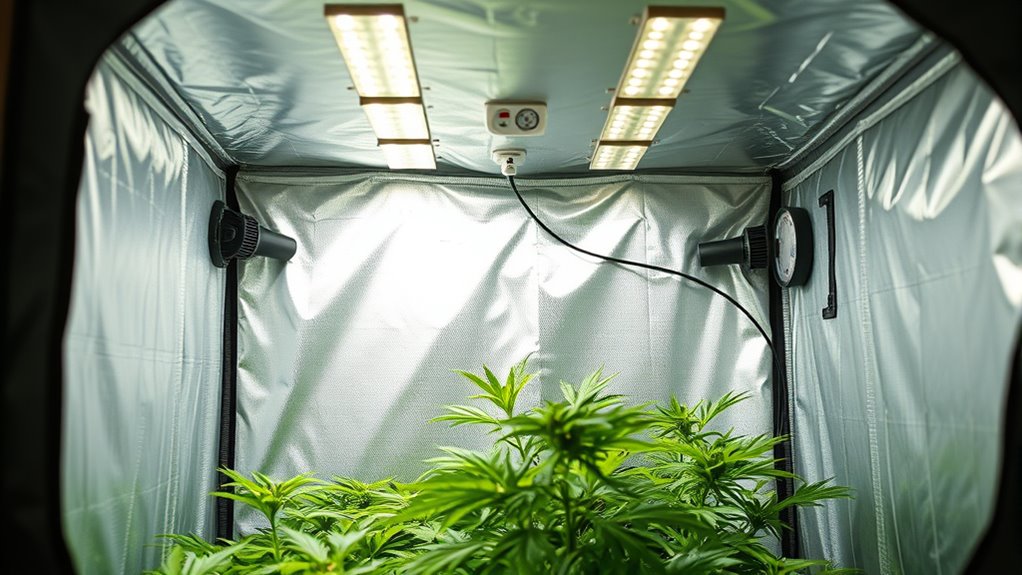
Maintaining proper environmental conditions inside your grow tent is crucial for healthy plant development. With effective environmental control, you can regulate temperature, humidity, and light management to optimize growth.
In indoor gardening, keeping the temperature between 20-28°C (68-82°F) encourages vigorous development, while humidity levels of 40-70% support foliage and prevent mold. During flowering, lower humidity helps reduce mold risks.
Using adjustable grow lights ensures your plants receive the right light intensity and spectrum, with even distribution to avoid hotspots. Reflective interior linings like Mylar maximize light efficiency by bouncing light back onto plants.
Regular monitoring and automation of thermostats, hygrometers, and timers help maintain stable conditions, making your grow tents a dependable environment for healthy, thriving plants. Proper storage conditions can also prevent issues related to excess moisture or inadequate ventilation that might harm your crops.
Odor Suppression and Privacy With Grow Tents
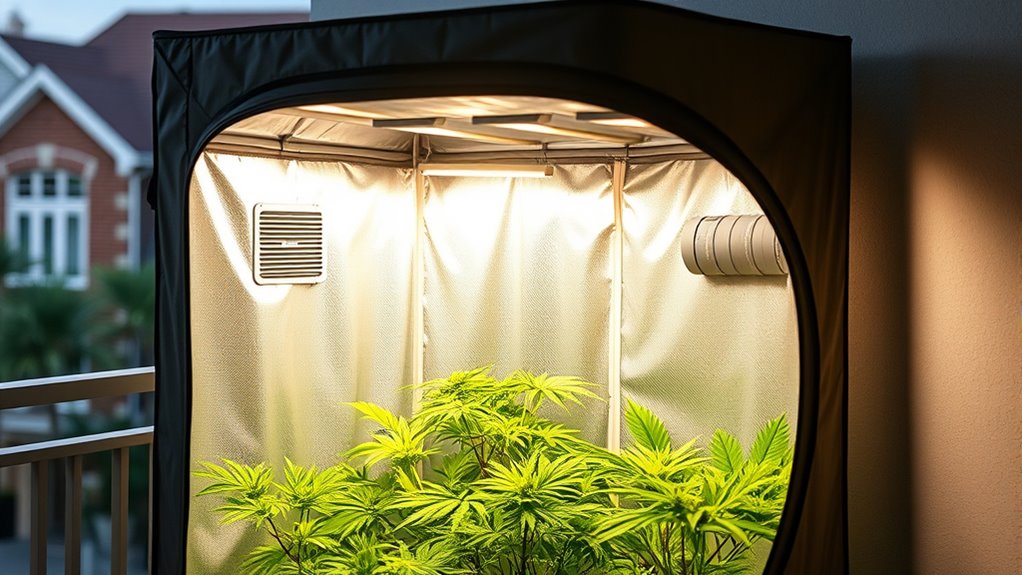
To keep odors contained and guarantee your grow tent remains discreet, proper ventilation and sealing are essential. Effective odor control relies on a combination of filtration and airtight seals to prevent smell leaks. Here are key tips:
Maintaining proper sealing and ventilation keeps odors discreet and prevents leaks effectively.
- Use activated carbon filters with your ventilation system to absorb odors.
- Seal vents and zippers with airtight zippers or duct tape to enhance privacy.
- Ensure good air circulation by placing exhaust fans correctly and maintaining negative pressure inside the tent.
- Regularly clean and replace filters to sustain superior odor absorption and prevent leaks.
Choosing the Right Size and Design for Urban Gardens
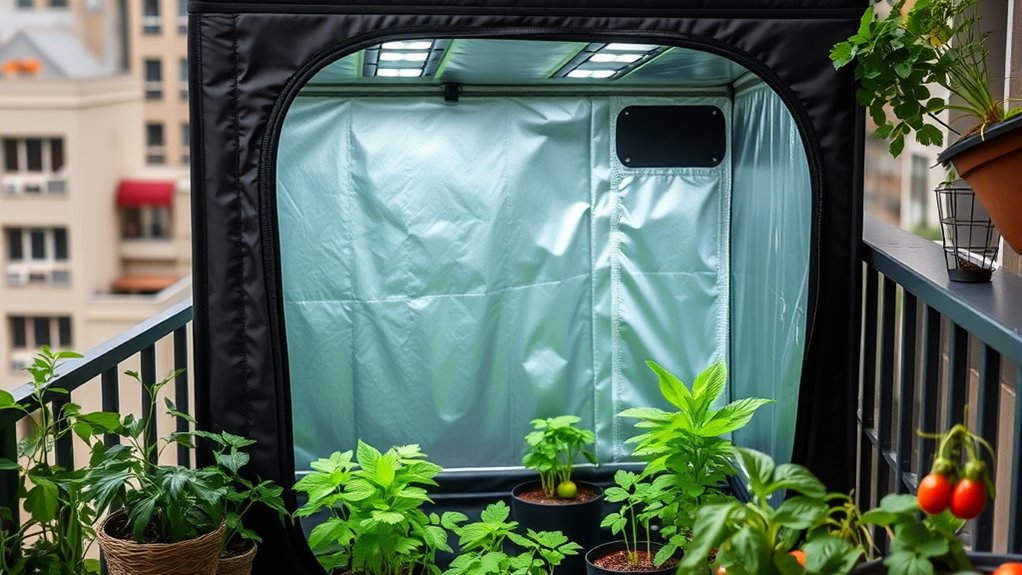
Choosing the right size and design for your urban garden’s grow tent is essential to maximize limited space and guarantee healthy plant growth. Your grow tent size, such as 2.3 x 2.3 meters, should match your available space and plant needs.
Indoor garden design benefits from a reflective interior, like Mylar, which boosts light distribution, improving efficiency.
Vertical grow tents are ideal for small urban spaces, as they optimize space efficiency by allowing more plants to grow upward without taking up extra ground area.
Proper sizing also ensures sufficient height and volume for different growth stages. Using size guides and considering your space constraints helps you select the perfect grow tent, creating a functional and productive urban gardening setup.
Equipment and Accessories to Maximize Growth Efficiency
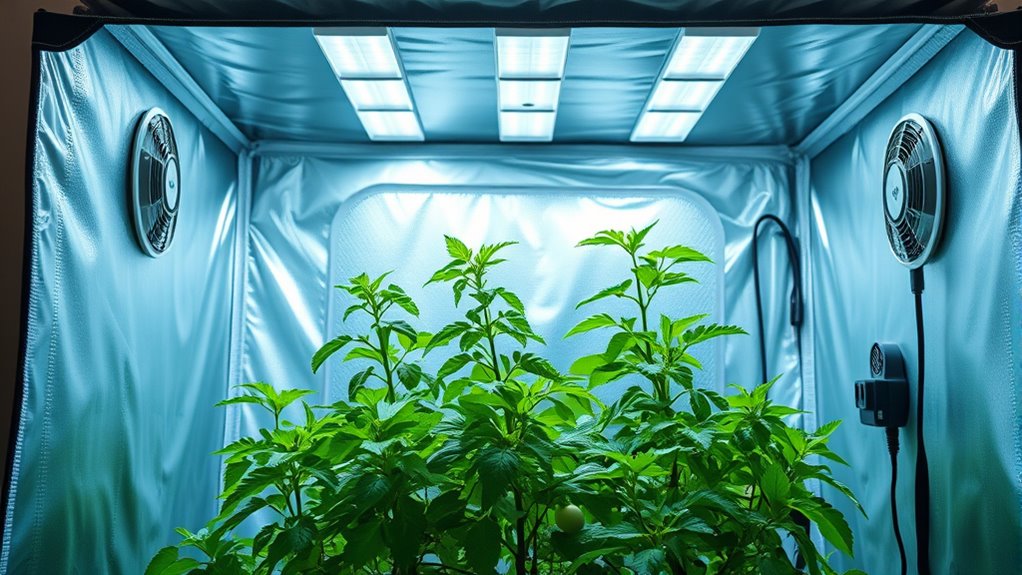
Maximizing growth in your urban grow tent depends heavily on the right equipment and accessories. Proper setup ensures your plants get ideal light, air, and environmental conditions.
- Use high-quality grow lights, such as full-spectrum LED models like the AC Infinity CLOUDLAB 844, to deliver consistent, vigorous growth.
- Install an efficient ventilation system, including inline duct fans and carbon filters, to maintain fresh airflow, control odors, and prevent mold.
- Incorporate reflective material, like Mylar liners, to maximize light efficiency by evenly distributing light across your plants.
- Add environmental monitoring devices, such as digital thermometers and hygrometers, to track temperature and humidity, enabling precise adjustments.
Adjustable hanging bars and straps help position equipment securely for the best results.
Maintenance Tips for Long-Term Success in Small Spaces
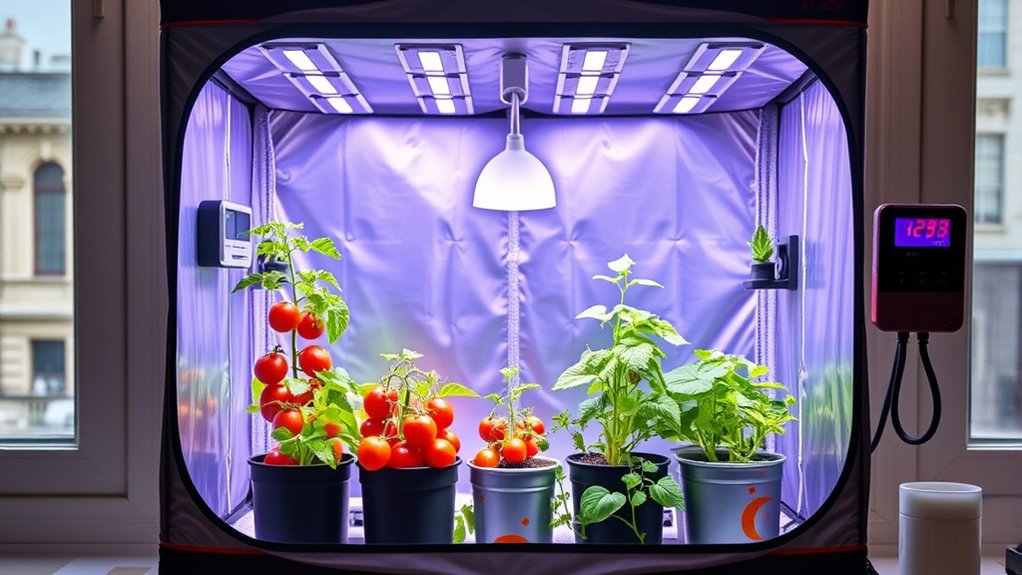
To keep your grow tent thriving, you need to stay on top of regular cleaning to prevent mold and pests.
Consistently monitor and calibrate your environmental sensors to guarantee your plants grow in the right conditions.
Keeping detailed logs of your maintenance activities helps you spot issues early and maintain long-term success.
Regular Cleaning Practices
Regular cleaning is essential for maintaining a healthy and productive grow tent, especially in small urban spaces. Proper cleaning and maintenance prevent mold, algae, and bacteria that can damage your plants. It also enhances ventilation and reduces pest risks.
To keep your grow tent in top shape, consider these steps:
- Wipe down interior surfaces with a mild disinfectant to prevent microbial buildup.
- Remove debris, dead leaves, and residue from trays and floors to minimize pests.
- Inspect vents, zippers, and access points regularly, and clean them to ensure proper airflow.
- Sanitize equipment like fans, lights, and sensors during routine maintenance for a healthy environment.
Sticking to these practices helps you maintain a clean, pest-free space, promoting long-term plant health and better yields.
Consistent Environmental Monitoring
Maintaining consistent environmental conditions is vital for the health and productivity of your plants in a small urban grow space. Regular monitoring of temperature and humidity using reliable digital sensors helps you keep conditions stable.
Calibrating sensors periodically guarantees accurate readings, preventing fluctuations that can stress your plants. Automated environmental control systems, like timers and smart devices, manage fans, heaters, and humidifiers, maintaining ideal conditions effortlessly.
Routine inspections are fundamental to identify malfunctions or sensor errors early, avoiding potential issues. Keeping a detailed maintenance log allows you to track environmental data, adjustments, and system performance over time.
This proactive approach ensures your grow tent remains a stable environment, supporting healthy growth and maximizing your gardening success in limited space.
Comparing Grow Tents With Other Indoor Growing Options
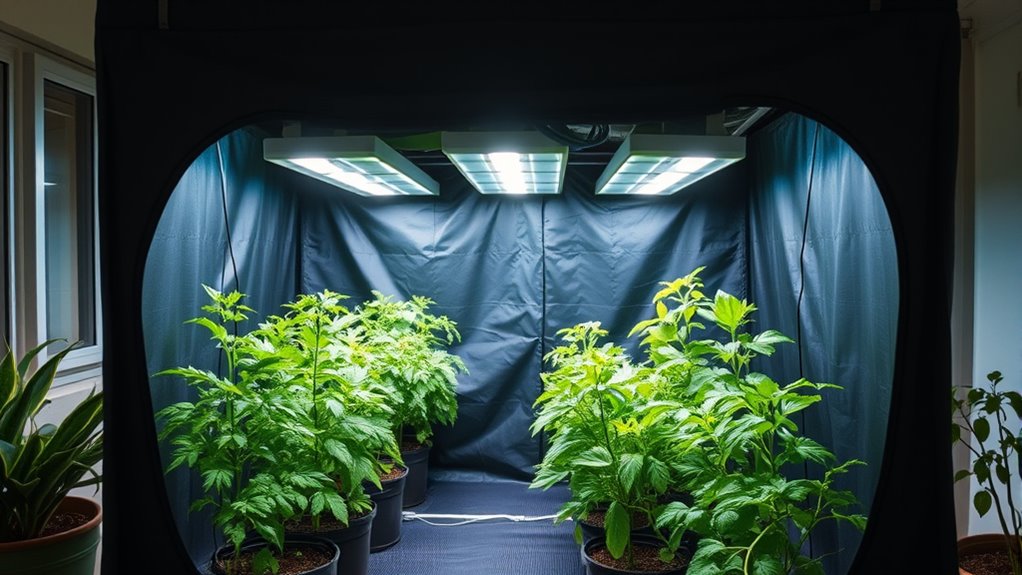
When comparing grow tents to other indoor growing options, you’ll find that they offer notable advantages in portability, setup speed, and cost. Grow tents are self-contained, making them easy to move and reconfigure without extensive planning.
They typically cost less and take less time to set up than custom grow rooms or permanent spaces. Here are some key points:
- Portability – Easily relocate your grow setup as needed.
- Quick setup – No need for extensive modifications or construction.
- Cost-effective – Lower initial investment compared to dedicated grow rooms.
- Optimized climate control – Reflective lining and pre-installed vents improve light efficiency and environment management.
Future Trends in Urban Indoor Gardening With Grow Tents

As urban gardening continues to evolve, grow tents are increasingly incorporating advanced technologies to enhance efficiency and sustainability. Smart environmental controls, like AI-powered sensors and automated climate management, make your grow space more adaptable to urban climates.
Advances in LED technology provide higher PAR output with lower heat emissions, supporting sustainable urban gardening practices.
Modular grow systems are emerging, allowing you to maximize vertical space and scale your indoor garden easily.
Odor-proofing and filtration innovations ensure discreet, organic, and pesticide-free cultivation.
Additionally, eco-friendly materials and durable fabrics boost the longevity of grow tents, making them a sustainable choice for long-term urban cultivation.
These trends point toward smarter, more efficient, and eco-conscious indoor gardening solutions for city dwellers.
Frequently Asked Questions
What Is the Point of a Grow Tent?
You might wonder what a grow tent is for. Its main purpose is to give you a controlled space where your plants can thrive. It manages light, temperature, and humidity, making sure your plants get the perfect environment.
Plus, it’s portable, easy to set up, and keeps odors and pests out. With a grow tent, you can grow healthy plants year-round, no matter your outdoor conditions.
Do Grow Tents Make a Difference?
Yes, grow tents definitely make a difference. They give you a controlled environment where you can optimize light, temperature, and humidity, ensuring your plants grow stronger and faster.
The reflective interior boosts light efficiency, and you’ll also contain odors and pests. Plus, their portability and quick setup mean you can easily start or adjust your indoor garden.
Do Plants Grow Faster in Grow Tents?
Yes, plants grow faster in grow tents because you control environmental factors like temperature, humidity, and light, which reduces stress.
The reflective interior evenly distributes light, boosting photosynthesis. You also get better air circulation and CO2 levels, speeding up growth.
Are Grow Tents Worth It for Vegetables?
Imagine a lush, green oasis thriving indoors—are grow tents worth it for your vegetables? Absolutely. They give you a controlled environment, boosting growth, reducing pests, and enabling year-round harvests.
With reflective interiors and proper ventilation, you’ll see healthier, tastier produce faster. Investing in a grow tent transforms your space into a mini-farm, making it totally worth it for fresh, homegrown veggies anytime you want.
Conclusion
Embrace the power of grow tents, your secret weapon in transforming tiny urban spaces into thriving green havens. Like a magic wand, they turn limitations into possibilities, making lush gardens accessible anywhere. With the right setup and care, you’ll uncover nature’s potential right at your fingertips. Don’t let small spaces hold you back—dive into urban gardening with confidence and watch your indoor oasis flourish beyond imagination. The future of city greening starts now, beneath your own roof.
